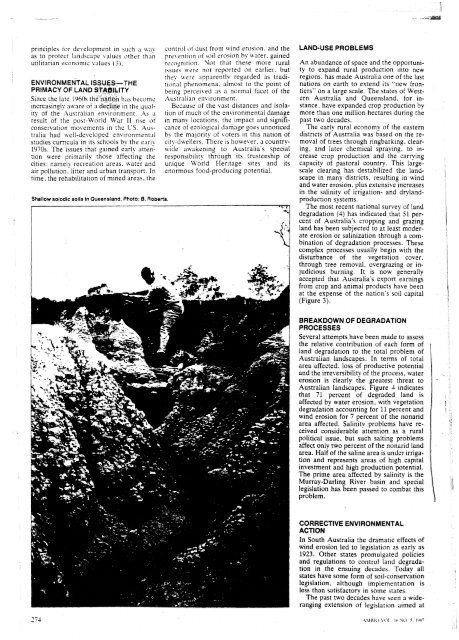soil-conservation-people-religion-and-land.pdf - South West NRM
soil-conservation-people-religion-and-land.pdf - South West NRM
soil-conservation-people-religion-and-land.pdf - South West NRM
Create successful ePaper yourself
Turn your PDF publications into a flip-book with our unique Google optimized e-Paper software.
principles ror de~elopment In \uch d \,I control ot du\t from nind erovon. <strong>and</strong> the<br />
as to protect Idndscape ~alues other than pre\entir,n of \o~l erovon by water. gained<br />
utilitarian economic L alues (3).<br />
recc>gnitic>n Not that these more rural<br />
i\sue\ \\ere not reported on earlier. but<br />
the). Lvere ;iPParently regarded as tradi-<br />
ENVIRONMENTAL ISSUES-THE tional phenomena. almost to the point of<br />
PRIMACY OF LAND ST+B&ITY<br />
being perceived as a normal facet of the<br />
Since the late 1960s theZe&G h;ir become Australian enn*ironrnent.<br />
~ncreasingly aware of a t3eeE-e In the qual- Because of the vast distances <strong>and</strong> isolaity<br />
of the Australian environment. .As a tion of much of the environmental damage<br />
result of the po\t-LVorld War I1 rise of in many locations. the impact <strong>and</strong> signifi<strong>conservation</strong><br />
moi.ements in the CS. z4~~-<br />
cance of ecolopical damage goes unnoticed<br />
tralia had \\ell-developed env~ronmentul by the majority of \.oters in this nation of<br />
studies curricula In its schools by the earl! city-dwellers. There is however. a country-<br />
1970s. The issues that gained early atten- n ide atvakenins to Australia's special<br />
tion were primarily those affecting the responsibility through its trusteeship of<br />
cities: namely recreation areas. water <strong>and</strong> unique World Heritage sites <strong>and</strong> its<br />
air pollution. litter <strong>and</strong> urban transport. In enormous food-producing potential.<br />
time. the rehabilitation of mined areas. the<br />
Shallow solodic <strong>soil</strong>s in Queensl<strong>and</strong>. Photo: 8. Roberts.<br />
LAND-USE PROBLEMS<br />
An abundance of space <strong>and</strong> the opportunity<br />
to exp<strong>and</strong> rural production into new<br />
regions. has made Australia one of the last<br />
nations on earth to extend its "new frontiers"<br />
on a large scale. The states of <strong>West</strong>ern<br />
Australia <strong>and</strong> Queensl<strong>and</strong>. for instance.<br />
have exp<strong>and</strong>ed crop production by<br />
more than one million hectares during the<br />
past two decades.<br />
The early rural economy of the eastern<br />
districts of Australia was based on the removal<br />
of trees through ringbarking. clearing,<br />
<strong>and</strong> later chemical spraying, to increase<br />
crop production <strong>and</strong> the carrying<br />
capacity of pastoral country. This largescale<br />
clearing has destabilized the l<strong>and</strong>scape<br />
in many districts, resulting in wind<br />
<strong>and</strong> water erosion, plus extensive increases<br />
in the salinity of irrigation- <strong>and</strong> dryl<strong>and</strong>production<br />
systems.<br />
The most recent national survey of l<strong>and</strong><br />
degradation (4) has indicated that 51 percent<br />
of Australia's cropping <strong>and</strong> grazing<br />
l<strong>and</strong> has been subjected to at least moderate<br />
erosion or salinization through a combination<br />
of degradation processes. These<br />
complex processes usually begin with the<br />
disturbance of the vegetation cover.<br />
through tree removal. overgrazing or injudicious<br />
burning. It is now generally<br />
accepted that Australia's export earnings<br />
from crop <strong>and</strong> animal products have been<br />
at the expense of the nation's <strong>soil</strong> capital<br />
(Figure 3).<br />
BREAKDOWN OF DEGRADATION<br />
PROCESSES<br />
Several attempts have been made to assess<br />
the relative contribution of each form of<br />
l<strong>and</strong> degradation to the total problem of<br />
Australian l<strong>and</strong>scapes. In terms of total<br />
area affected. loss of productive potential<br />
<strong>and</strong> the irreversibility of the process, water<br />
erosion is clearly the greatest threat to<br />
Australian l<strong>and</strong>scapes. Figure 4 indicates<br />
that 71 percent of degraded l<strong>and</strong> is<br />
affected by water erosion, with vegetation<br />
degradation accounting for 11 percent <strong>and</strong><br />
wind erosion for 7 percent of the nonarid<br />
area affected. Salinity problems have received<br />
considerable attention as a rural<br />
political issue, but such salting problems<br />
affect only two percent of the nonarid l<strong>and</strong><br />
area. Half of the saline area is under irrigation<br />
<strong>and</strong> represents areas of high capital<br />
investment <strong>and</strong> high production potential.<br />
The prime area affected by salinity is the<br />
Murray-Darling River basin <strong>and</strong> special<br />
legislation has been passed to combat this<br />
problem.<br />
CORRECTIVE ENVIRONMENTAL<br />
ACTION<br />
In <strong>South</strong> Australia the dramatic effects of<br />
wind erosion led to legislation as early as<br />
1923. Other states promulgated policies<br />
<strong>and</strong> regulations to control l<strong>and</strong> degradation<br />
in the ensuing decades. Today all<br />
states have some form of <strong>soil</strong>-<strong>conservation</strong><br />
legislation. although implementation is<br />
less than satisfactory in some states.<br />
The past two decades have seen a wideranging<br />
extension of legislation aimed at
















